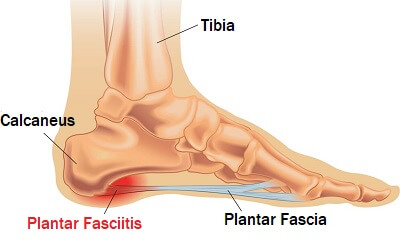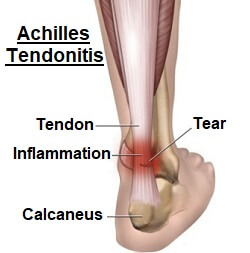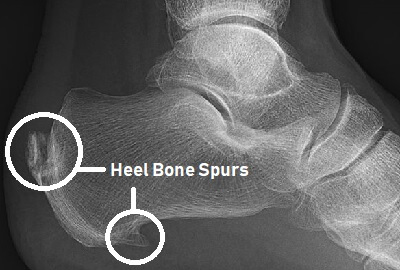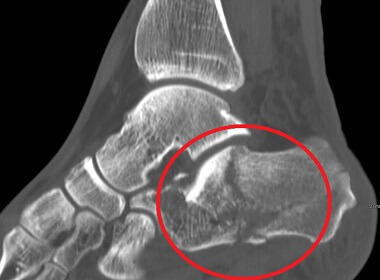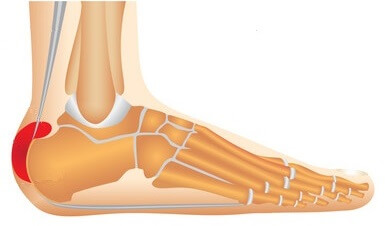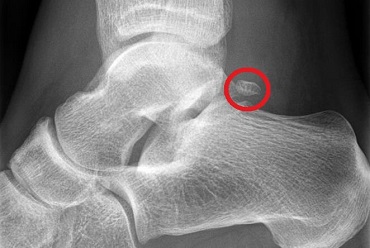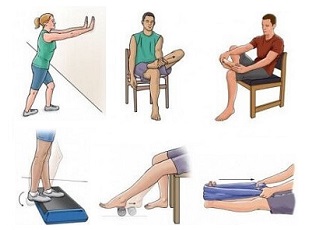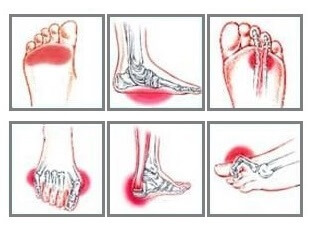- Home
- Diagnosis Guide
- Heel Pain
Heel Pain Causes & Treatment
Written By: Chloe Wilson BSc(Hons) Physiotherapy
Reviewed By: FPE Medical Review Board
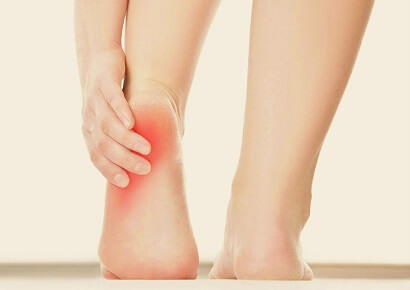
Heel pain causes all kinds of problems affecting day to day activities like walking, running and even sleeping.
The heel bone, aka calcaneus, is the largest bone in the foot, absorbing most of the impact when we are walking and running so it is no wonder we are so prone to sore heels.
There may be back of heel pain, pain on the side of the heel or pain underneath the heel of the foot depending on the underlying cause.
In most cases sore heels develop gradually over time but occasionally they can be the result of an injury. Often, heel pain causes secondary problems too, as we walk differently to try and reduce the pain.
With the right treatment for pain in the heel of the foot symptoms usually settle down fairly quickly and even in prolonged cases, heel pain causes are rarely serious.
Common Heel Pain Causes
There are a number of different heel pain causes each of which are associated with different symptoms. We will start by having a brief look at each one and then go on to find out more about the best treatment for heel pain.
1. Plantar Fasciitis
One of the most common heel pain causes is plantar fasciitis. It is the most common cause of pain underneath the heel and affects around 1-in-10 people.
The plantar fascia is a thick band of tissue the runs under the sole of the foot.
Plantar fasciitis develops when there is excess strain through the plantar fascia from overuse e.g. being on your feet for long periods, muscle weakness and tightness, altered foot biomechanics or obesity. This places strain on the heel where the plantar fascia originates resulting in pain under the heel and into the foot arch.
Plantar fasciitis heel pain causes problems when standing on tip toes or going upstairs and is often worse after periods of prolonged rest e.g. sleeping or watching TV. It may also lead to bump on the bottom of the foot.
You can find out loads more about this common cause of foot heel pain in the Plantar Fasciitis section including causes, treatment and prevention options.
2. Achilles Tendonitis
Another common cause of pain in the heel of the foot is Achilles tendonitis.
The achilles tendon is a thick tendon which connects the calf muscles to the back of the heel. Achilles tendonitis is a common cause of back of heel pain resulting in discomfort, pain and a lump on the back of the heel.
Repetitive strain on the achilles tendon, usually from muscle weakness, tightness or friction, leads to inflammation and degeneration of the achilles tendon resulting in back of foot pain.
Achilles heel pain causes stiffness and pain in the heel, ankle and calf that tends to be worse after rest. There may be swelling or a painful lump on the back of the heel in the tendon or just above the ankle associated with achilles heel pain.
Achilles tendonitis is one of the slower heel pain causes to recover as the achilles tendon has a poor blood supply which slows healing. The earlier treatment for the back of heel pain starts, the quicker symptoms will settle.
You can find out loads more about the causes, treatment options and prevention strategies of achilles heel pain in the Achilles Tendonitis section.
3. Bone Spurs
Calcaneal bone spurs can develop at the back of the heel or underneath it, and are very common heel pain causes.
Heel bone spurs develop when excess calcium deposits form on the bone in response to repetitive friction. This tends to be from repetitive overuse e.g. running and jumping, muscle weakness and tightness or abnormal heel bone position.
The two most common types of bone spurs at the heel are:
- Haglunds Deformity: causes back of heel pain
- Inferior Bone Spurs: which develop underneath the heel causing heel arch pain
Bone spur heel pain causes problems when you first get up after resting and it often feels like you are standing on something sharp. This usually settles to a dull achy foot heel pain once you are moving around. Some people have no pain at all with heel bone spurs but there is usually a noticeable hard heel lump.
You can find out loads more about pain in the heel of the foot due to excess bone growth in Heel Bone Spurs section including causes, symptoms and treatment options.
4. Heel Fat Pad Syndrome
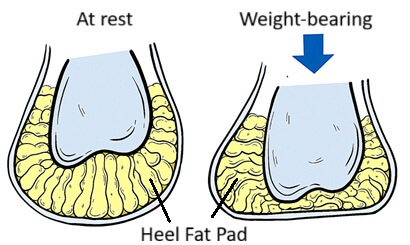
Heel pad syndrome is a condition where the fat pad under the heel thins or becomes irritated, leading to deep, bruise-like pain directly beneath the heel bone.
The pain tends to be right in the middle of the heel and gets worse with any pressure on the heel or if you squeeze on the sides of the heel.
Repetitive loading actions such as jumping or running, age and walking imbalances increases the pressure through the fat pad resulting in pain, especially when walking barefoot on hard surfaces.
Find out more about the causes, symptoms, diagnosis and treatment in the Heel Pad Syndrome section.
5. Heel Fractures
One of the most potentially serious heel pain causes is a fracture or break in the heel bone.
Heel fractures may be caused by:
- Repetitive Overloading: of the heel, e.g. jumping, running, causing stress fractures,
- Injuries: e.g. a fall from a height landing feet first.
Calcaneal fractures typically result in severe heel pain which can make it difficult to take any weight through the foot and are usually associated with significant foot swelling.
You can find out more about fractured heel pain causes, symptoms and treatment options in the Stress Fractures section.
6. Retrocalcaneal Bursitis
One of the most common heel pain causes associated with swelling at the back of the heel is retrocalcanel bursitis.
Also known as heel bursitis, this is where there is inflammation of the small sac at the back of the heel that protects the achilles tendon. If the bursa swells enough, you will notice a soft heel lump on the back of the calcaneus.
Repetitive pressure or friction on the bursa causes it to swell and achilles heel pain causes difficulty walking and running. Retrocalcaneal bursitis is usually caused by calf tightness, weakness or a sudden increase in activity levels.
Retrocalcaneal bursitis is one of the common heel pain causes in sporty adolescents, particularly when the are going through a growth spurt, as my son recently experienced!
Find out about how bursitis causes back of heel pain and how to treat it in the retrocalcaneal bursitis section.
7. Os Trigonum Syndrome
Os trigonum syndrome is one of the rarer heel pain causes, and tends to affect ballet dancers and athletes.
An os trigonum is a small extra bone fragment in the foot that only around 5-10% of people have. Often it goes completely unnoticed but if it gets stuck in the ankle joint it can irritate the surrounding soft tissues causing back of heel pain.
Os trigonum syndrome is usually caused by repetitive plantarflexion (foot pointing downwards) or an ankle injury, resulting in a deep, dull back of heel pain.
Find out more about the causes, symptoms and treatment options in the Os Trigonum Syndrome section.
8. Tarsal Tunnel Syndrome
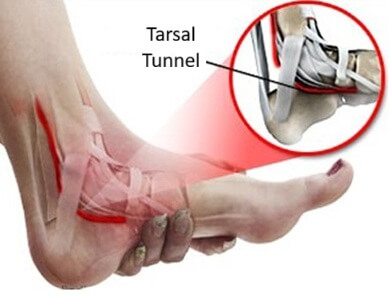
If your have side of heel pain with associated tingling and numbness in the foot, it is probably due to tarsal tunnel syndrome.
Tarsal Tunnel Syndrome develops when there is irritation of the tibial nerve where it passes through a narrow gap on the inner side of the foot known as the tarsal tunnel.
Anything which reduces the size of the tunnel such as swelling, ganglion cysts, arthritis, benign tumours or flat feet, places pressure on the tibial nerve.
Tarsal tunnel syndrome side of heel pain causes altered sensation on the inner side of the foot such as numbness, pins and needles and hot and cold sensations. Tarsal tunnel heel pain causes problems in one foot rather than both and symptoms are typically worse at night.
You can find out more about the causes, symptoms and treatment options for pain on the side of the heel in the Tarsal Tunnel Syndrome section.
Other Possible Causes
There are a some other conditions that can cause heel pain that extends into the foot:
- Ankle Sprain: over-stretching or tearing of one of the ankle ligaments
- Cuboid Syndrome: a common cause of ongoing pain on the outside of the heel after twisting your ankle
- Peroneal Tendonitis: inflammation of the peroneal tendon causing outer foot pain on the outside of the heel
- Posterior Tibial Tendonitis: inflammation of the posterior tibial tendon is a common inner side of heel pain cause
- Piezogenic Papules: a cluster of small flesh-coloured lumps around the heel that can cause pain
- Plantar Warts: small, rough, grainy lumps on the skin, often containing tiny black dots, caused by an infection
- Severs Disease: inflammation of the growth plate at the back of the heel in children
If there is any tingling, pins and needles or numbness in the heel, then it is likely to be linked to some nerve damage.
Heel Pain Treatment
The best heel pain treatment will depend on the underlying cause but will usually involve a combination of:
- Heel Stretches: one of the best ways to reduce back of heel pain is to do heel stretches targeting the calf muscles and plantar fascia
- Strengthening Exercises: treatment for heel pain usually involves strengthening the calf and glute muscles
- Rest: from aggravating activities to reduce the friction and irritation on the heel bone
- Ice: regularly applying ice can help reduce back of foot pain and inflammation
- Orthotics: Wearing special inserts in your shoes such as gel heel cups can help reduce most heel pain causes
You can find for more specific treatment advice using the links to the different heel pain causes above or visit the exercises for heel pain section.
Pain In Heel Recovery
Most heel pain causes are not serious and will settle down with a combination of appropriate rest and stretching and strengthening exercises with 6-12 weeks. Visit the exercises for heel pain section for a variety of exercises that are the basis of long term recovery from many foot and ankle heel pain causes.
Often, heel pain causes us to walk slightly differently, to reduce the pressure on the foot, which can cause problems further up the body, particularly the knee, hip and back. It is important to get an accurate foot pain diagnosis so do consult your doctor.
What Causes My Heel Pain?
There are lots of different heel pain causes which each lead to pain in slightly different areas of the foot.
Back of heel pain is usually from achilles tendonitis, heel bone spurs, heel bursitis or os trigonum.
Side of heel pain may be caused by tendonitis, tarsal tunnel syndrome or cuboid syndrome.
Heel and arch pain in the foot is most commonly caused by plantar fasciitis but may also be due to muscle cramps, plantar warts or plantar fibromatosis.
Outside heel pain may be caused by cuboid syndrome or peroneal tendonitis.
Inner side of heel pain is often due to posterior tibial tendonitis or tarsal tunnel syndrome.
Central heel pain is usually due to heel pad syndrome.
Foot and heel pain may be caused by a fracture, heel spur, plantar fasciitis, plantar warts or nerve pain.
A lump on the back of the heel may be caused by bone spurs (hard lump), bursitis (soft lump), piezogenic papules (cluster of small lumps).
A lump on the bottom of the heel is usually due to plantar fibroma, plantar wart or inferior bone spurs.
Side heel pain after running is usually caused by tendonitis or tarsal tunnel syndrome.
Heel Pain Causes Summary
Heel pain is a common problem and there are lots of possible heel pain causes. In most cases, foot heel pain comes on gradually due to overuse and repetitive friction.
The most common causes of heel pain are achilles tendonitis (back of heel pain), plantar fasciitis (heel and arch pain in the foot), bone spurs (hard lumps at the back or bottom of the heel) and bursitis (soft lump on heel of foot).
Heel pain may also be associated with other problems such as heel lumps and altered sensation.
Heel pain treatment usually involves a combination or rest, ice, medication and exercises. The best heel pain exercises involve a combination of heel stretches and strengthening exercises. Most heel pain causes will settle down within 6-12 weeks with the right treatment.
You may also be interested in the following articles:
- Pain On Top Of Foot
- Ball Of Foot Pain
- Foot Arch Pain
- Side Of Foot Pain
- Swollen Feet & Ankles
- Foot Lumps & Bumps
- Foot Pain In The Morning
Related Articles
Page Last Updated: 7th November, 2025
Next Review Due: 7th November, 2027
